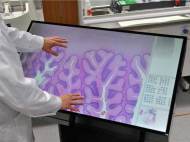FIMM and MultiTouch created multitouch display for microscopes
 Researchers at the Institute for Molecular Medicine Finland (FIMM) have in collaboration with the Finnish company Multitouch Ltd created a hand and finger gesture controlled microscope. WebMicroscope is a combination of web-based virtual microscopy and a giant-size multitouch display, and it was developed a few years ago by researchers at the universities of Helsinki and Tampere.
Researchers at the Institute for Molecular Medicine Finland (FIMM) have in collaboration with the Finnish company Multitouch Ltd created a hand and finger gesture controlled microscope. WebMicroscope is a combination of web-based virtual microscopy and a giant-size multitouch display, and it was developed a few years ago by researchers at the universities of Helsinki and Tampere.
By touching a table- or even wall-sized screen the user can navigate and zoom within a microscope sample in the same way as in a conventional microscope. Using the touch control it is possible to move from the natural size of the sample to a 1000-fold magnification, at which cells and even sub-cellular details can be seen.
“The sample viewing experience is like a combination of Google Maps and the user interface from the movie Minority Report”, said Johan Lundin, one of the creators of the method.
Biological samples are digitized using a microscopy scanner and stored on an image server. Samples displayed on the screen are then continuously read from the server over the internet and the size of a single sample can be up to 200 gigabytes.
“The multitouch microscope brings a new dimension into interactive teaching and the learning curve is practically zero as compared to conventional microscopy which can be quite challenging for students”, said Lundin.
The developers think that the method will revolutionize microscopy teaching where a group of students can stand around the display together with the teacher and examine the same sample. The multitouch microscope can recognize the hands of multiple users at the same time.
“At scientific meetings this technology is excellent in a situation where a group of users need to simultaneously view a microscopy sample, for example when a consensus needs to be reached concerning a new disease entity or a rare case”, said Lundin.
Although the technologies used to make the WebMicroscope are well known, this is the first case where they were combined in order to improve the interactivity and end results, as well as collaboration among its users.









This is a very interesting development that I’m sure many scientists will appreciate. However, I’m not sure that this type of screen can reproduce the quality of traditional optics.